First-Principle Study of the Interface of Al2O3/CoCr Metal-Based Composites
Abstract
:1. Introduction
2. Materials and Methods
2.1. CoCr Alloy Powder
2.2. Al2O3 Powder
2.3. Test Method
2.3.1. The Preparation Method of Al2O3/CoCr Composite Powder
2.3.2. SLM-Forming Test
2.3.3. Microstructure Measurement and Calculation
3. Results
3.1. The Physical Nature of CoCr
3.1.1. Crystal Structure
3.1.2. Electronic Structure
3.2. The Physical Nature of Al2O3
3.2.1. Crystal Structure
3.2.2. Electronic Structure
3.3. Convergence Test
3.3.1. The Convergence Test of Al2O3
3.3.2. The Convergence Test of CoCr
3.4. Al2O3/CoCr Interface Calculation
3.4.1. Al2O3/CoCr Interface Model
3.4.2. Al2O3/CoCr Interface Binding Performance
3.4.3. Combination Nature of the Al2O3/CoCr Interface
3.5. Effect of Al2O3 Addition on the Binding Strength of the Al2O3/CoCr Interface
3.5.1. Al2O3 Addition Quantity Theory Study
3.5.2. Effect of Al2O3 Content on the Binding Energy of the Al2O3/CoCr Interface
4. Discussion
4.1. Preparation and Properties of Al2O3/CoCr Composite Powder
4.2. Composition of the Forming Parts
4.3. Internal Micro-Organization of the Forming Parts
5. Conclusions
- The physical phase structure of Al2O3 and CoCr was optimized, and the convergence test was conducted to obtain the lattice constant. The Al2O3 surface structure converges at layer 7, with a surface energy of 5.97 J/m2. In the CoCr (111) surface, Co converges to layer 7 and the surface energy is 4.5 J/m2, while Cr converges to layer 7 and the surface energy is 4.21 J/m2.
- Three interface models were constructed to study the interface-binding capability, which showed that the strongest interface model with the calculation interface binding ability is Al2O3 (111)/CoCr (111). Under the interface, the Wad value is 2.33 J/m2, Wsep also has a maximum value of 2.12 J/m2, and Efor has a minimum value of 0.11 J/m2.
- Through the analysis of the interface wave density, the charge density, and the differential charge density, the Al2O3 (111)/CoCr (111) interface has the highest electron overlap, the strongest charge density, and the largest overlap interface; the charges of the Co and O atoms are transferred to the interface and across the interface; and a small charge is mixed together and accumulated during the transfer process. It is concluded that the interface binding strength of the Al2O3 (111)/CoCr (111) interface is the highest.
- By studying the effect of the Al2O3 addition amount on the binding strength of the Al2O3/CoCr interface, it can be found that adding a 5% content of Al2O3 makes the interface bind the best.
- The phase composition and microstructure of Al2O3/CoCr composites formed by SLM were analyzed. It was found that the microstructure of Al2O3/CoCr composites was uniform and dense after Al2O3 was added; the main phase composition was a-Co, ε-Co, M23C6, M6C, Al2O3, and CoAl2O4; and the grain size was finer.
Author Contributions
Funding
Institutional Review Board Statement
Informed Consent Statement
Data Availability Statement
Acknowledgments
Conflicts of Interest
References
- Hedberg, Y.S.; Qian, B.; Shen, Z.; Virtanen, S.; Wallinder, I.O. In vitro biocompatibility of CoCrMo dental alloys fabricated by selective laser melting. Dent. Mater. 2014, 30, 525–534. [Google Scholar] [CrossRef] [PubMed]
- Qian, B.; Saeidi, K.; Kvetková, L.; Lofaj, F.; Xiao, C.; Shen, Z. Defects-tolerant Co-Cr-Mo dental alloys prepared by selective laser melting. Dent. Mater. 2015, 31, 1435–1444. [Google Scholar] [CrossRef]
- Vittayakorn, W.; Poolphol, P.; Aimprakod, K.; Maluangnont, T. Processing Development and Properties of Cobalt-Chromium Alloys Fabricated by Traditional Method. Mater. Today Proc. 2021, 43, 2629–2634. [Google Scholar] [CrossRef]
- Şahin, M.; Ünalan, F.; Mutlu, I. Corrosion, ion release, and surface hardness of Ti-6Al-4V and cobalt-chromium alloys produced by CAD-CAM milling and laser sintering. J. Prosthet. Dent. 2022, 128, 529.e1–529.e10. [Google Scholar] [CrossRef]
- Chen, G.; Wang, Z.; Wang, H.; Zhao, X.; Hu, J.; Wang, S.; Zhang, S. Effects of tetrahedral amorphous carbon film deposited on dental cobalt–chromium alloys on bacterial adhesion. Surf. Coatings Technol. 2012, 206, 3386–3392. [Google Scholar] [CrossRef]
- Javdani, A.; Daei-Sorkhabi, A.H. Microstructural and mechanical behavior of blended powder semisolid formed Al7075/B 4 C composites under different experimental conditions. Trans. Nonferrous Met. Soc. China 2018, 28, 1298–1310. [Google Scholar] [CrossRef]
- Mandal, V.; Tripathi, P.; Kumar, A.; Singh, S.S.; Ramkumar, J. A study on selective laser melting (SLM) of TiC and B4C reinforced IN718 metal matrix composites (MMCs). J. Alloys Compd. 2021, 901, 163527. [Google Scholar] [CrossRef]
- Timbó, I.C.; Oliveira, M.S.; Regis, R.R. Effect of sanitizing solutions on cobalt-chromium alloys for dental prostheses: A systematic review of in vitro studies. J. Prosthet. Dent. 2022, in press. [Google Scholar] [CrossRef]
- Wang, R.; Gu, D.; Huang, G.; Shi, K.; Yuan, L.; Zhang, H. Multilayered Gradient Titanium-Matrix Composites Fabricated by Multi-Material Laser Powder Bed Fusion Using Metallized Ceramic: Forming Characteristics, Microstructure Evolution, and Multifunctional Properties. Addit. Manuf. 2023, 62, 103407. [Google Scholar] [CrossRef]
- Cui, G.; Qian, Y.; Bian, C.; Gao, G.; Hassani, M.; Liu, Y.; Kou, Z. CoCrNi matrix high-temperature wear resistant composites with micro- and nano-Al2O3 reinforcement. Compos. Commun. 2020, 22, 100461. [Google Scholar] [CrossRef]
- Ostolaza, M.; Arrizubieta, J.I.; Queguineur, A.; Valtonen, K.; Lamikiz, A.; Ituarte, I.F. Influence of process parameters on the particle-matrix interaction of WC-Co metal matrix composites produced by laser-directed energy deposition. Mater. Des. 2022, 223, 111172. [Google Scholar] [CrossRef]
- Bandyopadhyay, A.; Shivaram, A.; Isik, M.; Avila, J.D.; Dernell, W.S.; Bose, S. Additively manufactured calcium phosphate reinforced CoCrMo alloy: Bio-tribological and biocompatibility evaluation for load-bearing implants. Addit. Manuf. 2019, 28, 312–324. [Google Scholar] [CrossRef]
- Yan, L.I.U.; Liang, L.I.; Lu, G.L.; Han, Z.W.; Liu, J.D.; Yu, S.R. Fractal characteristics and wettability of Nano-Al2O3/Ni-Co composite coating prepared by electrodeposition. Trans. Nonferrous Met. Soc. China 2011, 21, s380–s383. [Google Scholar]
- Gökog, G. First principles electronic structure calculations of Co2CrBi Heusler system. Phys. B Condens. Matter 2010, 405, 2162–2165. [Google Scholar] [CrossRef]
- Arif, H.; Tahir, M.; Sagir, M.; Alrobei, H.; Alzaid, M.; Ullah, S.; Hussien, M. Effect of potassium on the structural, electronic, and optical properties of CsSrF3 fluro perovskite: First-principles computation with GGA-PBE. Optik 2022, 259, 168741. [Google Scholar] [CrossRef]
- Ke, D.; Pan, Y.; Wu, T.; Wang, J.; Xu, X.; Pan, Y. Effect of W/B atomic ratio on the microstructure and mechanical properties of WCoB-TiC ceramic composites: First-principles calculations and experiment. J. Mater. Res. Technol. 2020, 9, 8744–8753. [Google Scholar] [CrossRef]
- Todorova, T.Z.; Gaier, M.; Zwanziger, J.W.; Plucknett, K.P. Understanding the elastic and thermal response in TiC-based ceramic-metal composite systems: First-principles and mechanical studies. J. Alloys Compd. 2019, 789, 712–719. [Google Scholar] [CrossRef]
- Wang, Q.; Bai, P.; Zhao, Z. First Principle Study of TiB (2) (0001)/gamma-Fe (111) Interfacial Strength and Heterogeneous Nucleation. Materials 2021, 14, 1573. [Google Scholar] [CrossRef]
- Yang, G.; Liu, Y.; Hang, Z.; Xi, N.; Fu, H.; Chen, H. Adhesion at cerium doped metal-ceramic α-Fe/WC interface: A first-principles calculation. J. Rare Earths 2019, 37, 773–780. [Google Scholar] [CrossRef]
- Dmitriev, S.V.; Yoshikawa, N.; Kohyama, M.; Tanaka, S.; Yang, R.; Kagawa, Y. Atomistic structure of the Cu (111) /α-Al2O3 (0001) interface in terms of interatomic potentials fitted to ab initio results. Acta Mater. 2004, 52, 1959–1970. [Google Scholar] [CrossRef]
- Dmitriev, S.V.; Yoshikawa, N.; Kohyama, M.; Tanaka, S.; Yang, R.; Tanaka, Y.; Kagawa, Y. Modeling interatomic interactions across Cu/α–Al2O3 interface. Comput. Mater. Sci. 2006, 36, 281–291. [Google Scholar] [CrossRef]
- Qiu, Z.; Shang, J.; Bi, X.; Gong, S.; Xu, H. Study of electronic structure in Co/Al2O3/Co heterojunctions from first principles. Acta Mater. 2004, 52, 533–537. [Google Scholar] [CrossRef]
- Kim, H.G.; Kim, W.R.; Park, H.W.; Bang, G.B.; Jung, K.H.; Son, Y.; Lim, S.H. Microstructural study of the nano-scale martensitic lamellar α-Co and ε-Co phases of a Co–Cr alloy fabricated by selective laser melting. J. Mater. Res. Technol. 2021, 12, 437–443. [Google Scholar] [CrossRef]
- Antunes, L.H.; de Lima, C.R. Cobalt-Chromium Alloys—Properties and Applications. Ref. Modul. Mater. Sci. Mater. Eng. 2018. [Google Scholar] [CrossRef]
- CCDC. Available online: http://www.ccdc.cam.ac.uk/cgi-bin/catreq.cgi (accessed on 12 July 2020).
- Luo, M.; Li, C.; Liu, Q.; Yang, Z.; Wang, Y.; Li, H. β-Mo2C/γ-Al2O3 catalyst for one step CO hydrogenation to produce alcohols. Catal. Today 2022, 402, 328–334. [Google Scholar] [CrossRef]
- Xie, H.; Zhao, N.; Shi, C.; He, C.; Liu, E. Effects of active elements on adhesion of the Al2O3/Fe interface: A first principles calculation. Comput. Mater. Sci. 2021, 188, 110226. [Google Scholar] [CrossRef]
- Akbarzadeh, A.; Ahmadlouydarab, M.; Niaei, A. Capabilities of α-Al2O3, γ-Al2O3, and bentonite dry powders used in flat plate solar collector for thermal energy storage. Renew. Energy 2021, 173, 704–720. [Google Scholar] [CrossRef]
- Smirnova, N.S.; Baeva, G.N.; Markov, P.V.; Mashkovsky, I.S.; Bukhtiyarov, A.V.; Zubavichus, Y.V.; Stakheev, A.Y. In situ FTIR study of surface site transformations in Pd3In/α-Al2O3 and Pd3Ag/α-Al2O3 induced by CO adsorption. Mendeleev Commun. 2022, 32, 807–809. [Google Scholar] [CrossRef]
- Economist, T. A third industrial revolution. Economist 2012, 403, a3–a4. [Google Scholar]
- Yu, Y.; Zhong, L.; Deng, C.; Bai, H.; Zhu, J.; Zhao, N.; Peng, J. Mechanical properties and chemical bonding transitions of Nb/NbC and α-Fe/NbC interfaces in Fe-Nb-C composites. Mater. Today Commun. 2022, 33, 104791. [Google Scholar] [CrossRef]
- Wood, M.; Ward-Close, M. Fibre-reinforced intermetallic compounds by physical vapour deposition. Mater. Sci. Eng. A 1995, 192, 590–596. [Google Scholar] [CrossRef]
- Mukherjee, S.; De, I. Feature extraction from handwritten documents for personality analysis. In Proceedings of the 2016 International Conference on Computer, Electrical & Communication Engineering (ICCECE), Kolkata, India, 16–17 December 2016; pp. 1–8. [Google Scholar] [CrossRef]
- Ha, S.H.; Yoshimi, K.; Nakamura, J.; Kaneko, T.; Maruyama, K.; Tu, R.; Goto, T. Experimental study of Moss–T2, Moss–Mo3Si–T2, and Mo3Si–T2 eutectic reactions in Mo-rich Mo–Si–B alloys. J. Alloys Compd. 2014, 594, 52–59. [Google Scholar] [CrossRef]
- Y.T. 1702-2020, Dentistry—Additive Manufacturing—Selective Laser Melting Metallic Materials for Fixed and Removable Restorations and Appliances. Available online: https://wenku.so.com/d/bca4f278bb33b53560e3117c4925dfa2 (accessed on 26 April 2020).
- Chang, F.; Gu, D.; Dai, D.; Yuan, P. Selective laser melting of in-situ Al4SiC4 + SiC hybrid reinforced Al matrix composites: Influence of starting SiC particle size. Surf. Coat. Technol. 2015, 272, 15–24. [Google Scholar] [CrossRef]
- Zhao, C.; Zhou, J.; Mei, Q.; Ren, F. Microstructure and dry sliding wear behavior of ultrafine-grained Co-30 at% Cr alloy at room and elevated temperatures. J. Alloys Compd. 2019, 770, 276–284. [Google Scholar] [CrossRef]
- Zhou, Y.; Wei, W.; Yan, J.; Liu, W.; Li, N.; Li, H.; Xu, S. Microstructures and metal-ceramic bond properties of Co-Cr biomedical alloys fabricated by selective laser melting and casting. Mater. Sci. Eng. A 2019, 759, 594–602. [Google Scholar] [CrossRef]
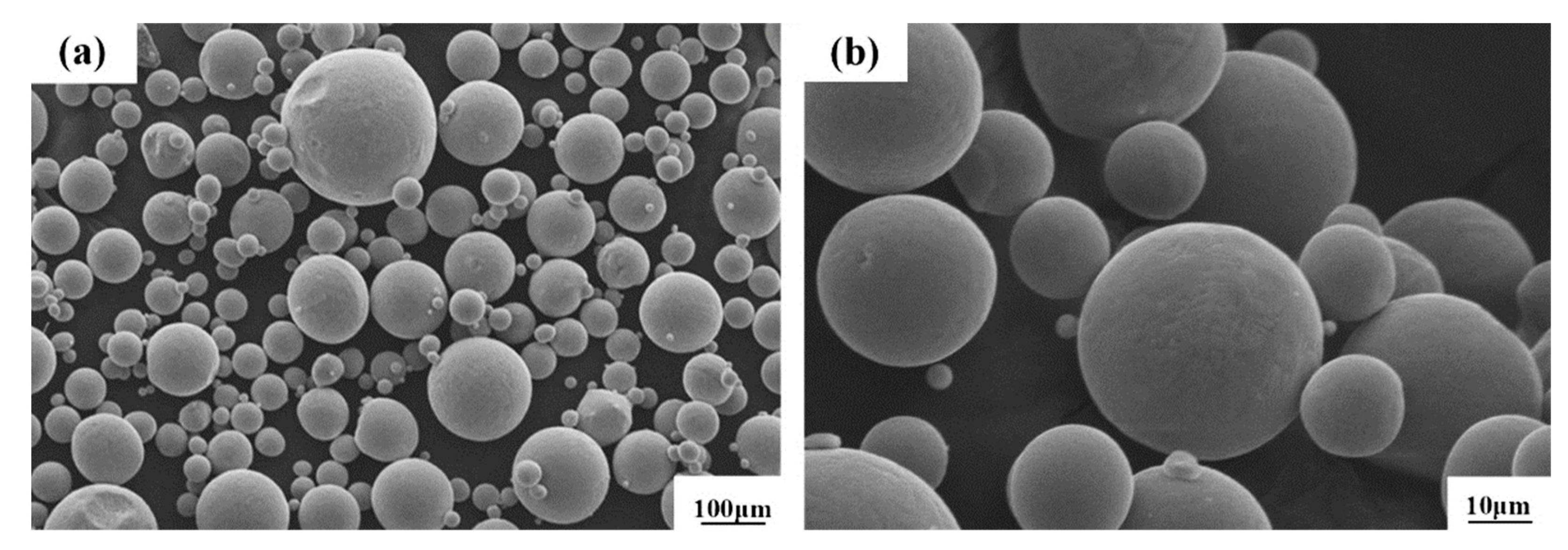

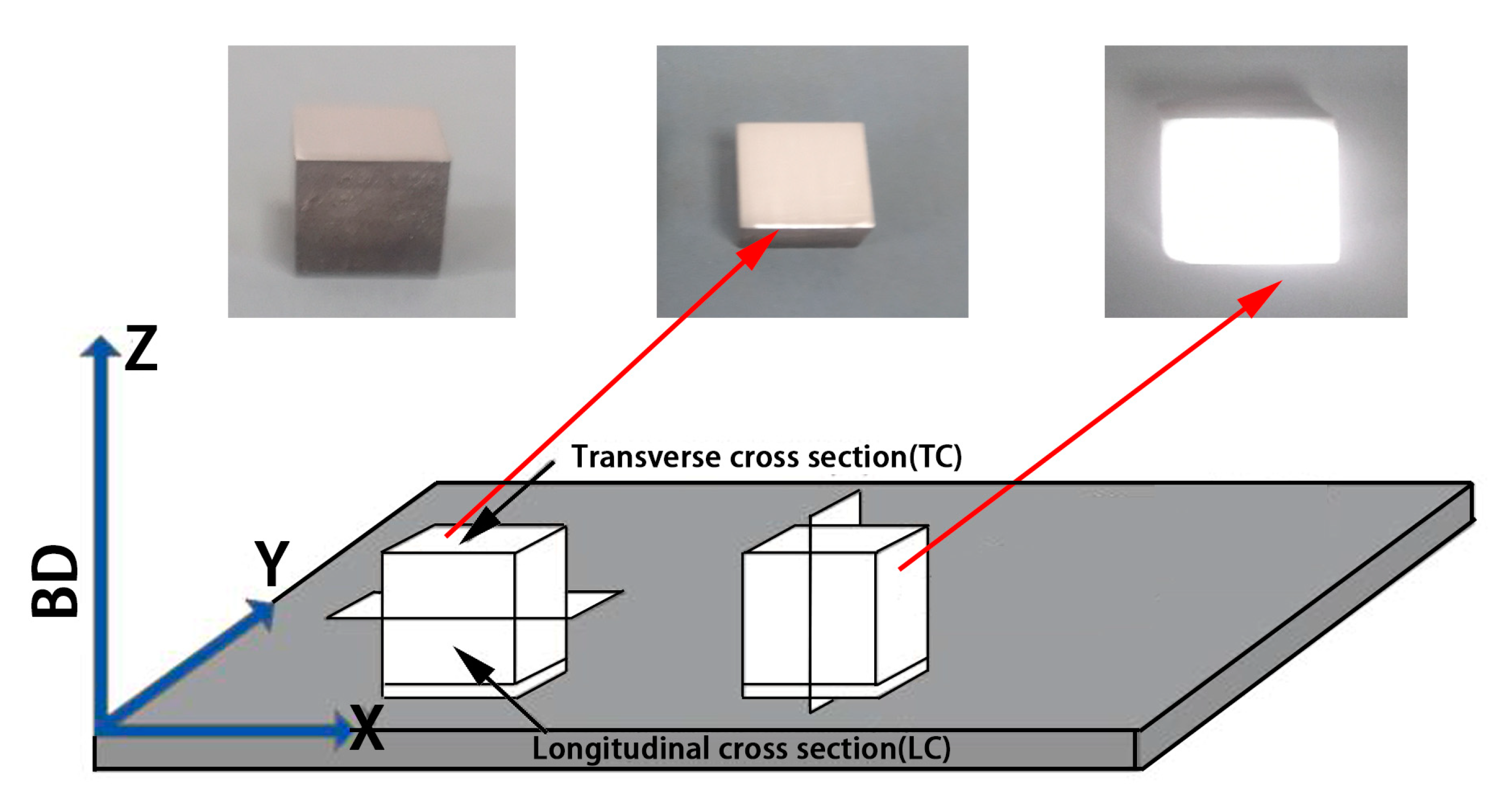
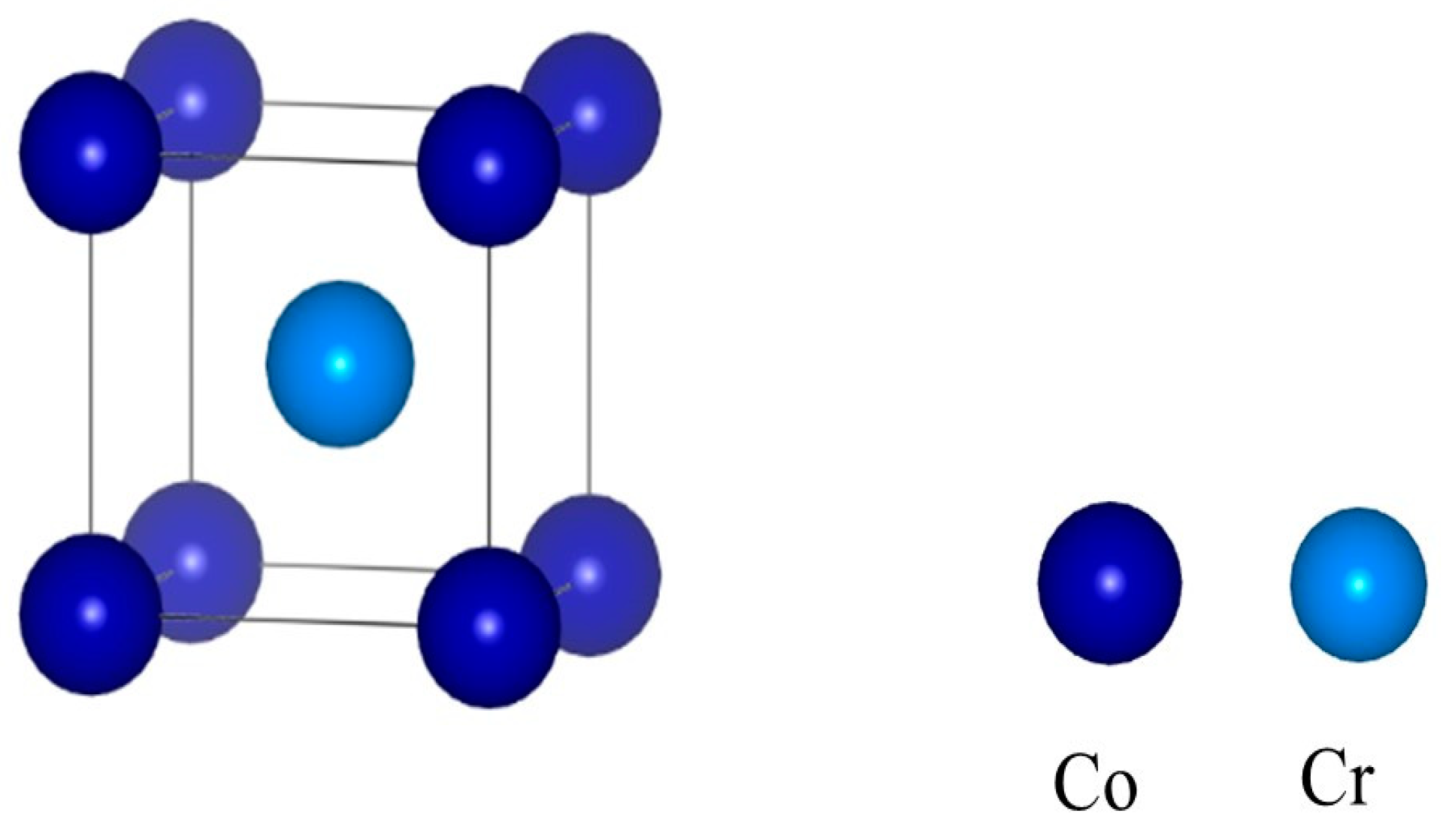
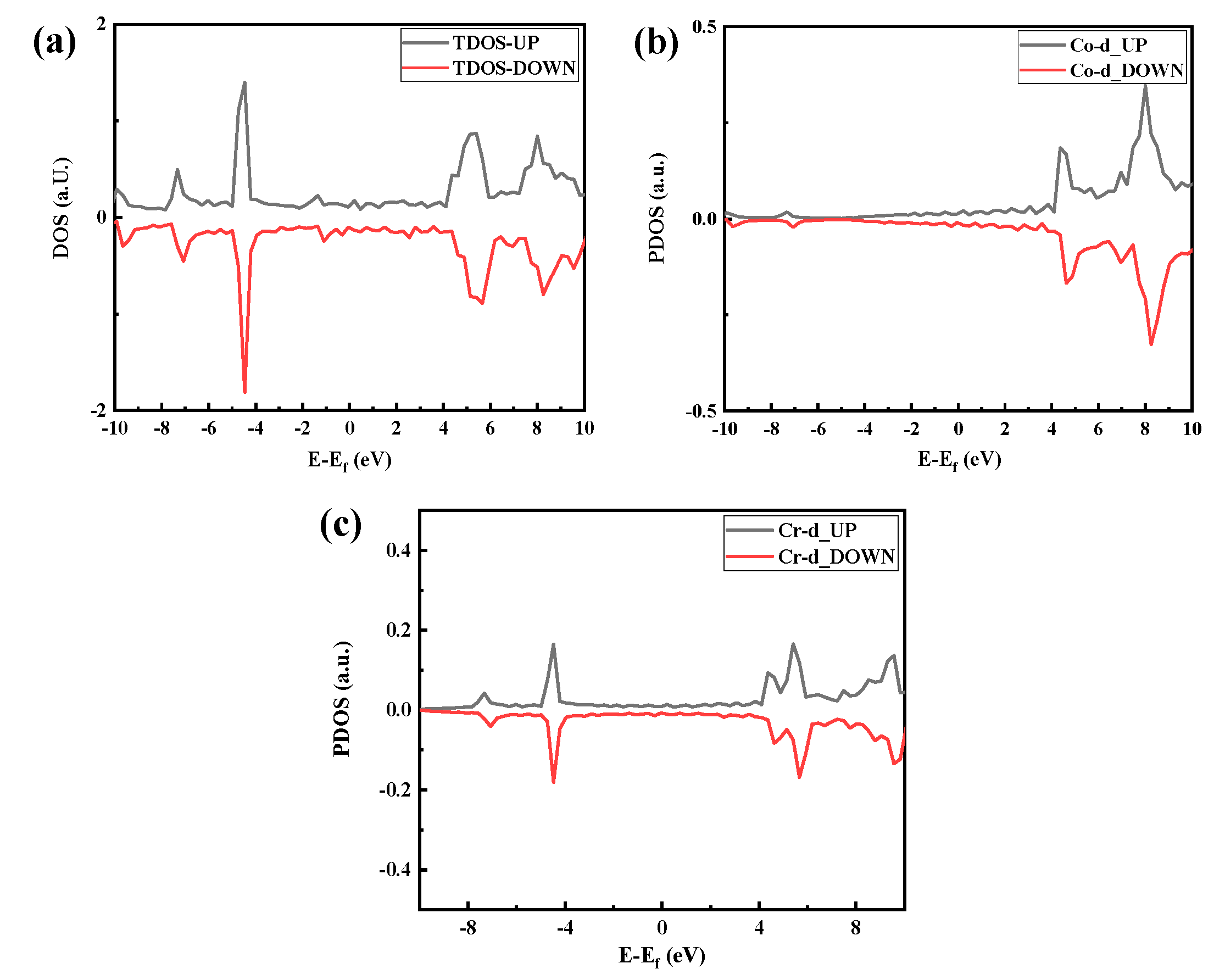

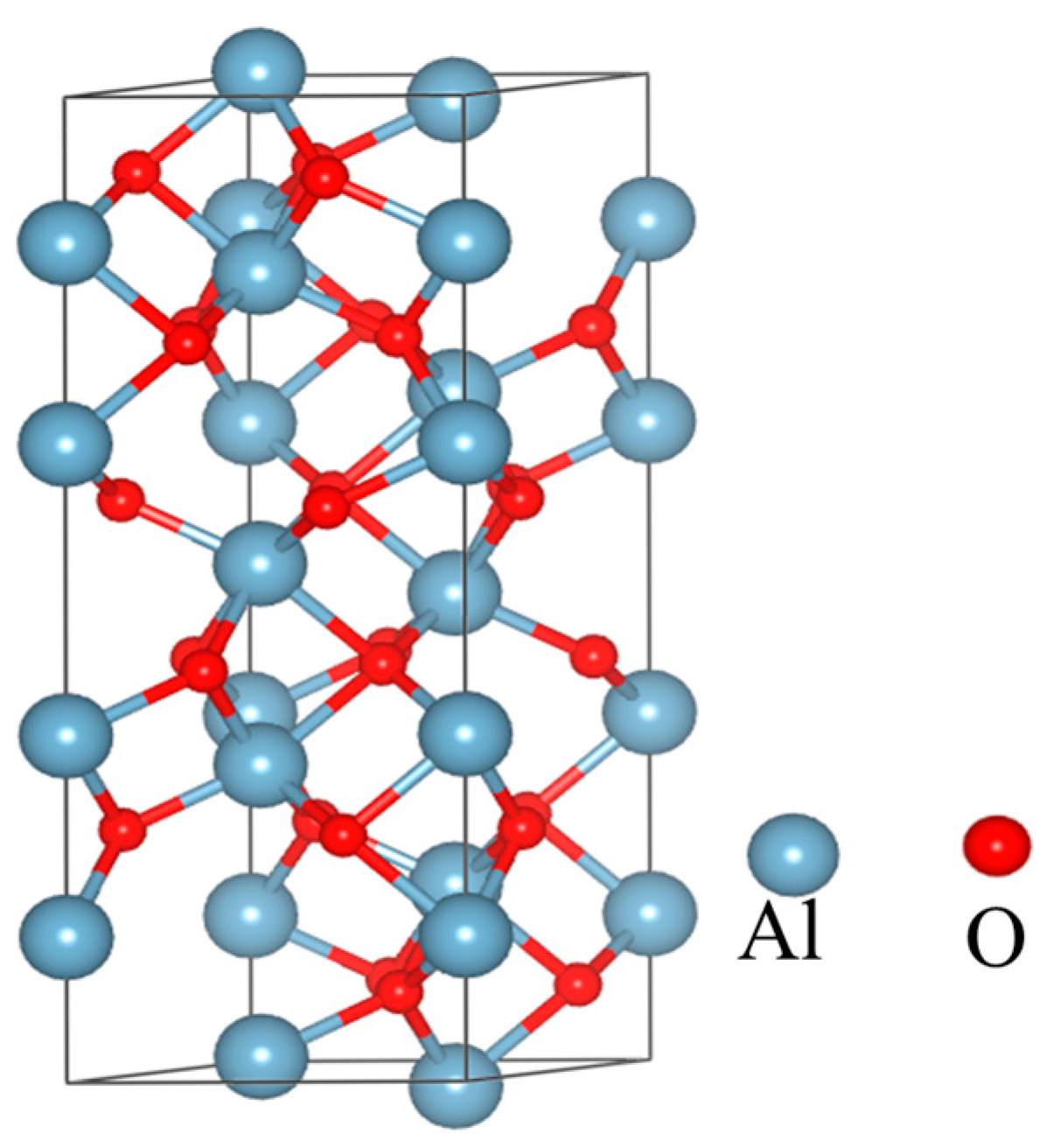
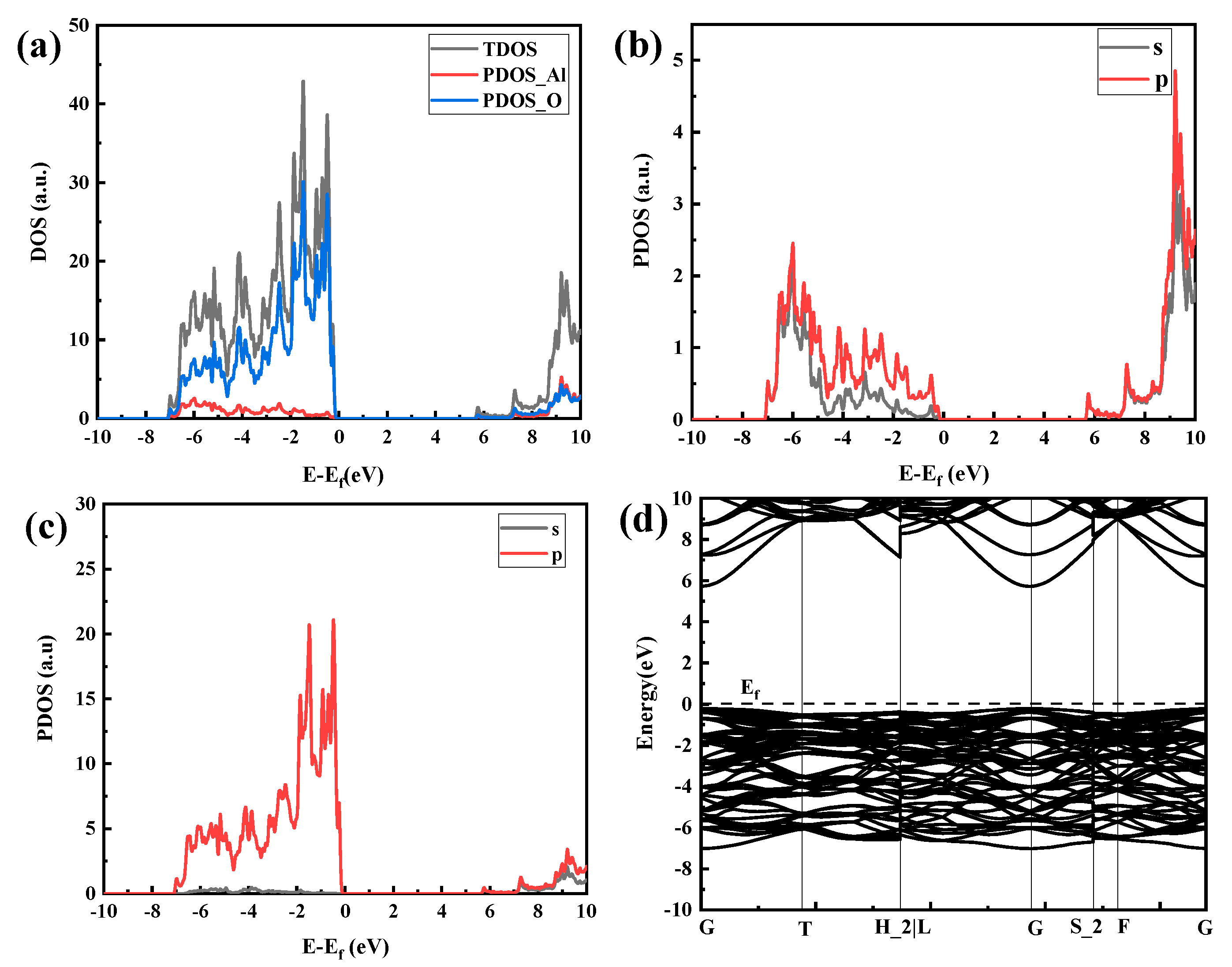
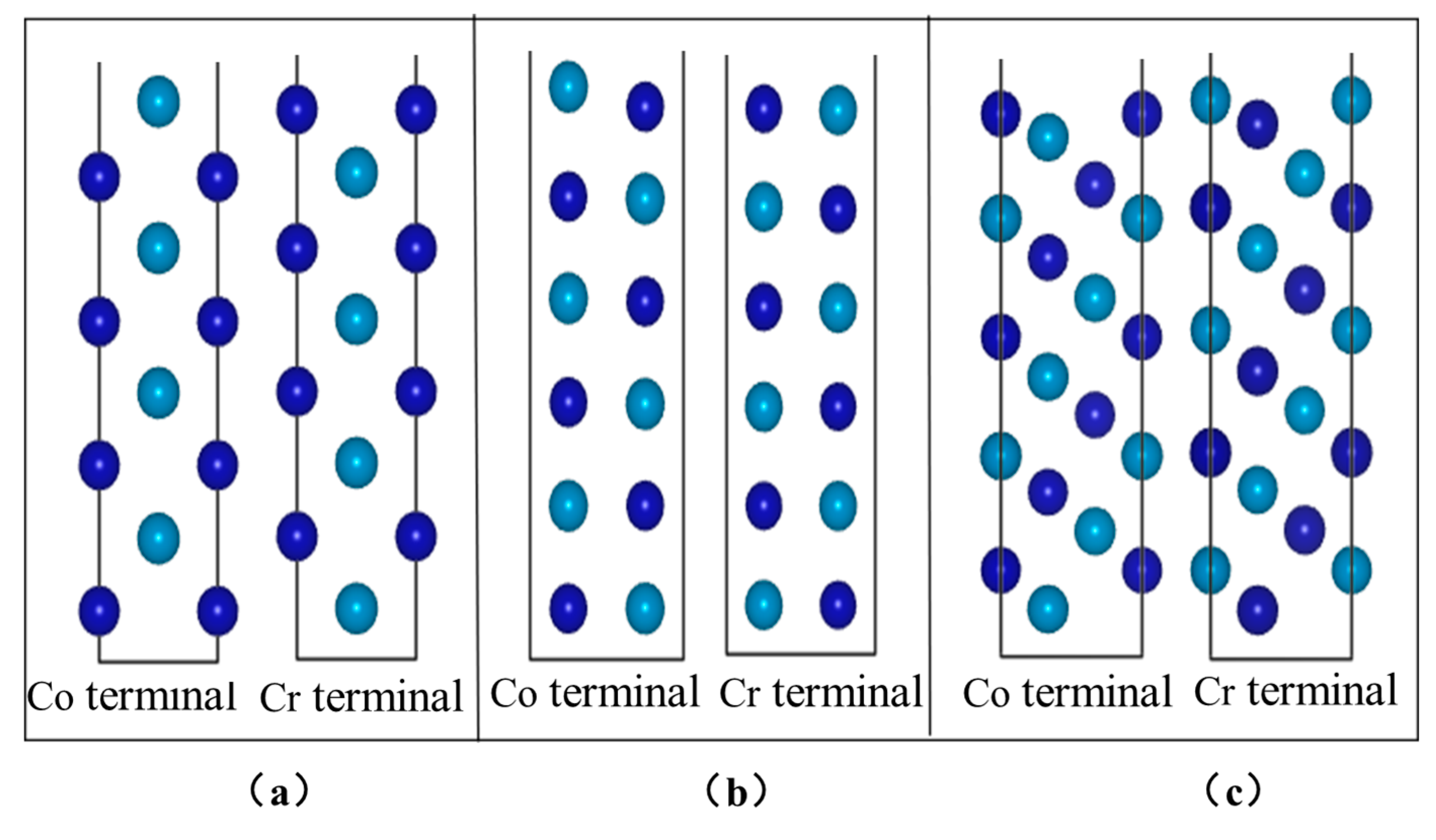
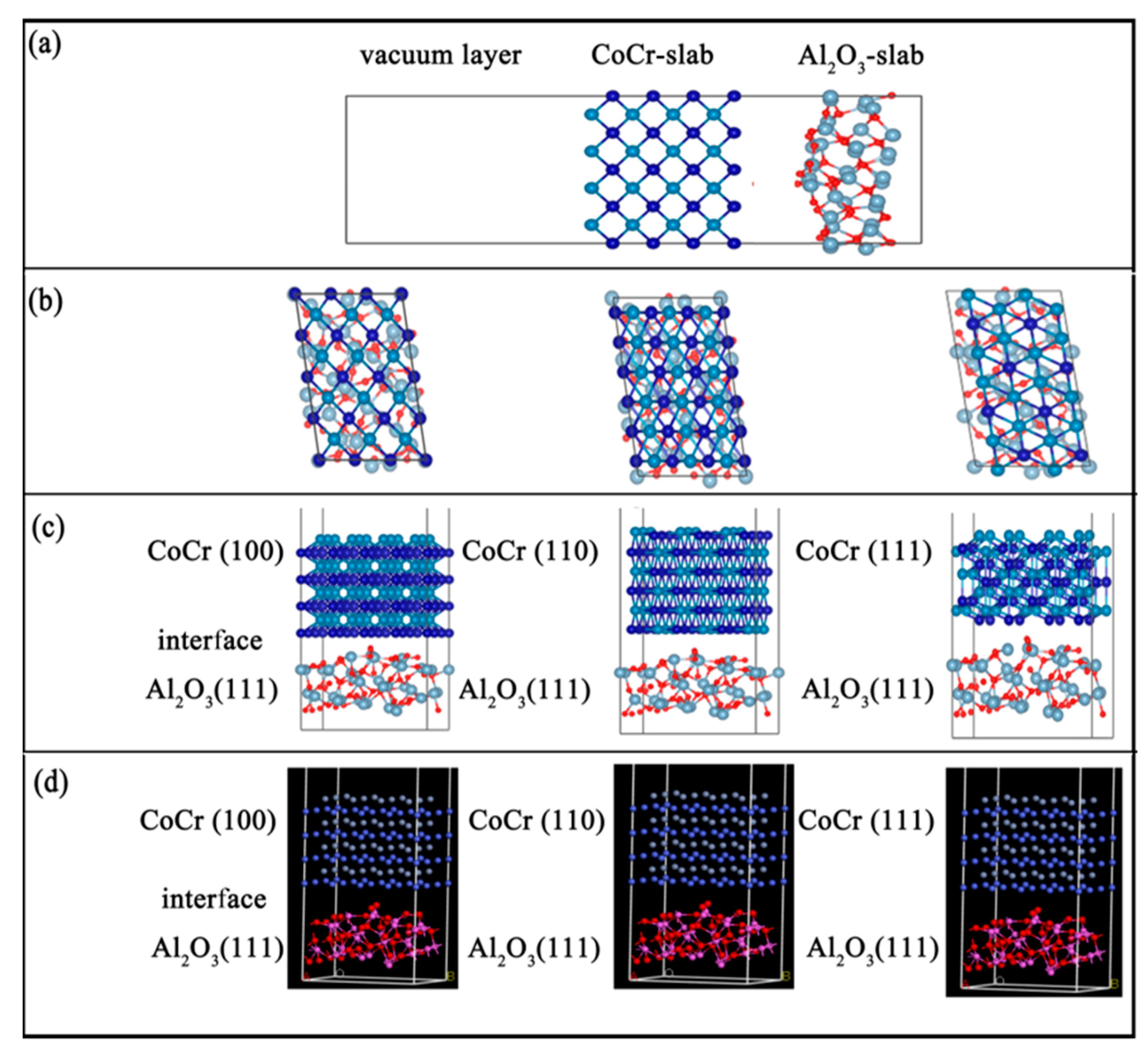
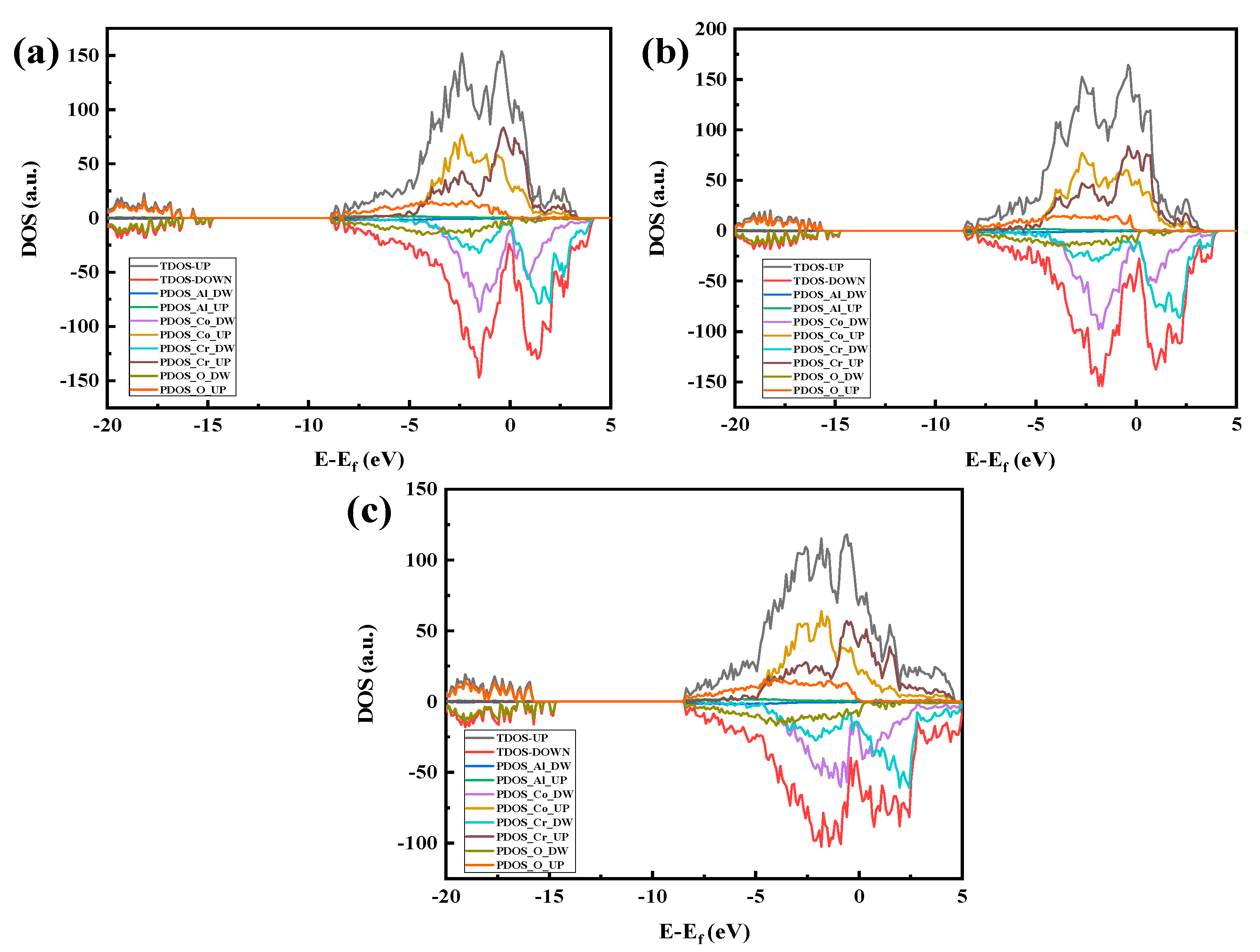
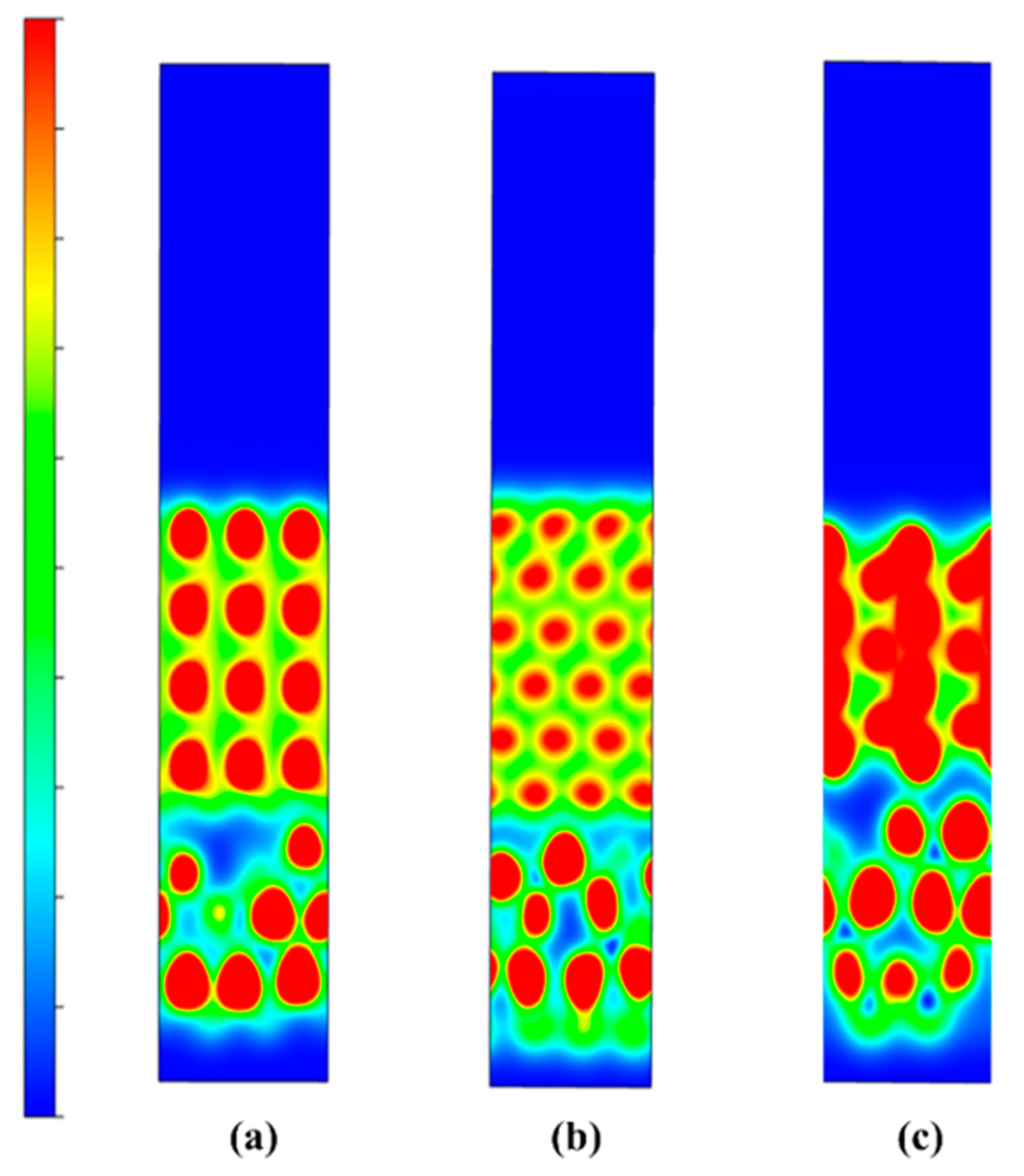


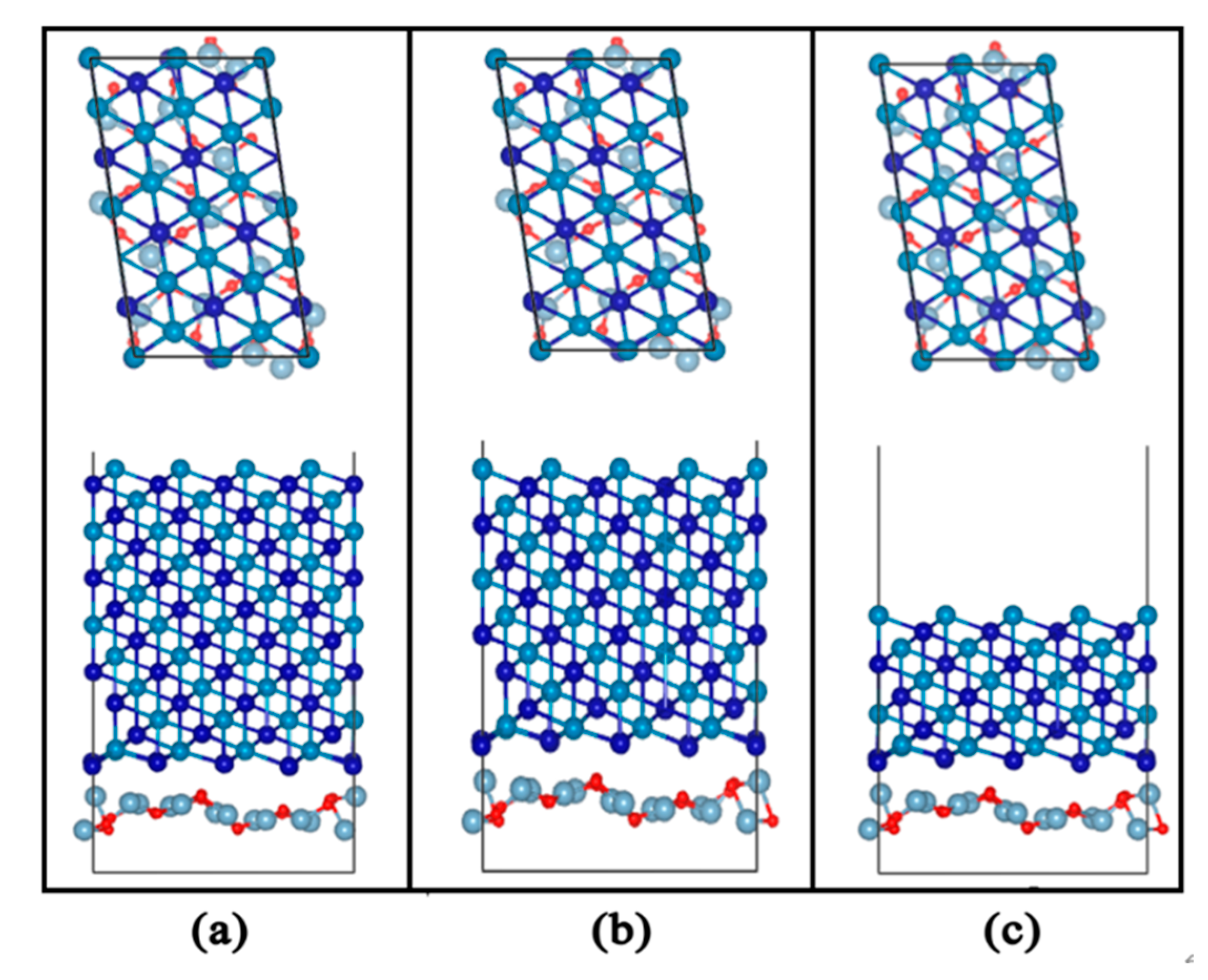
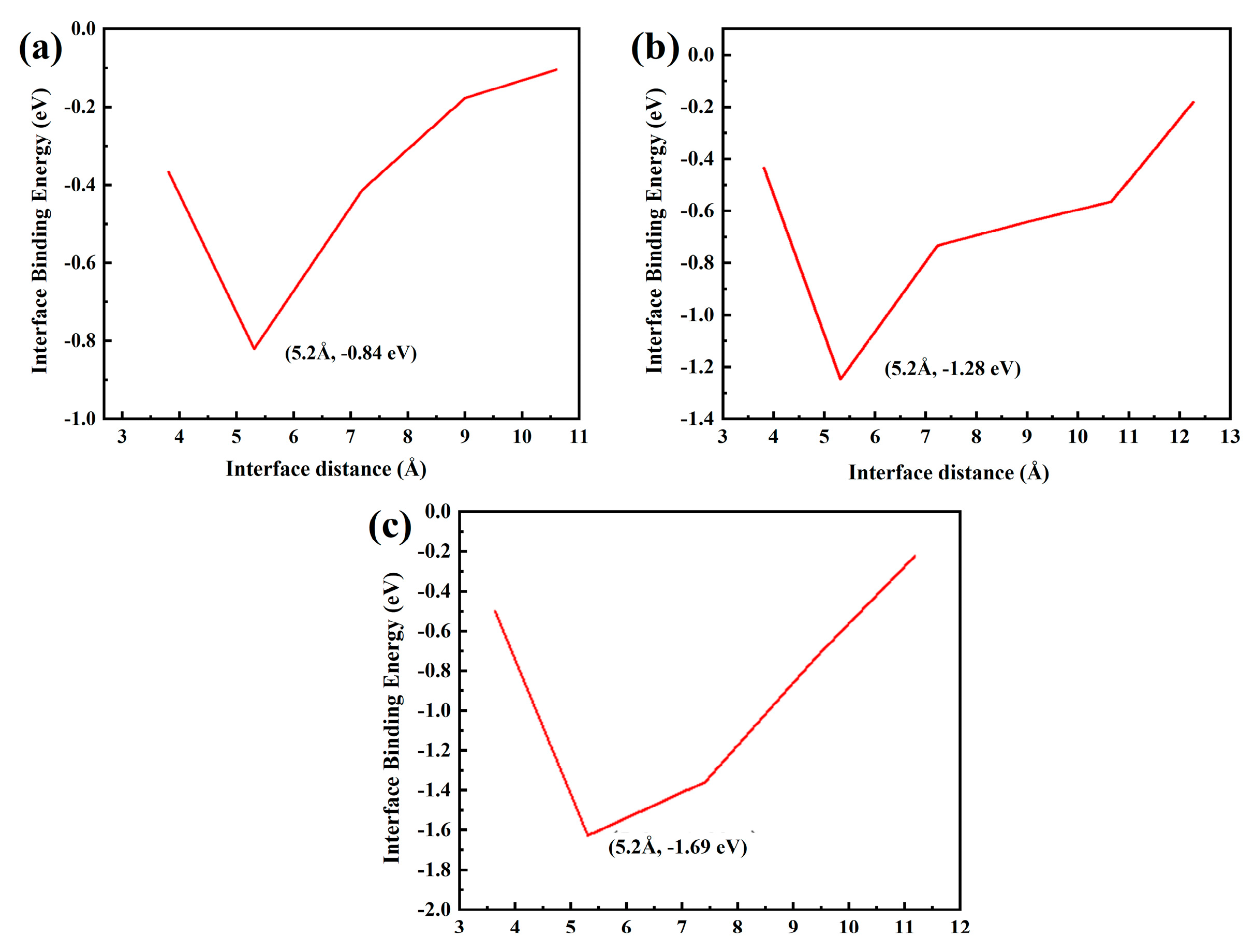
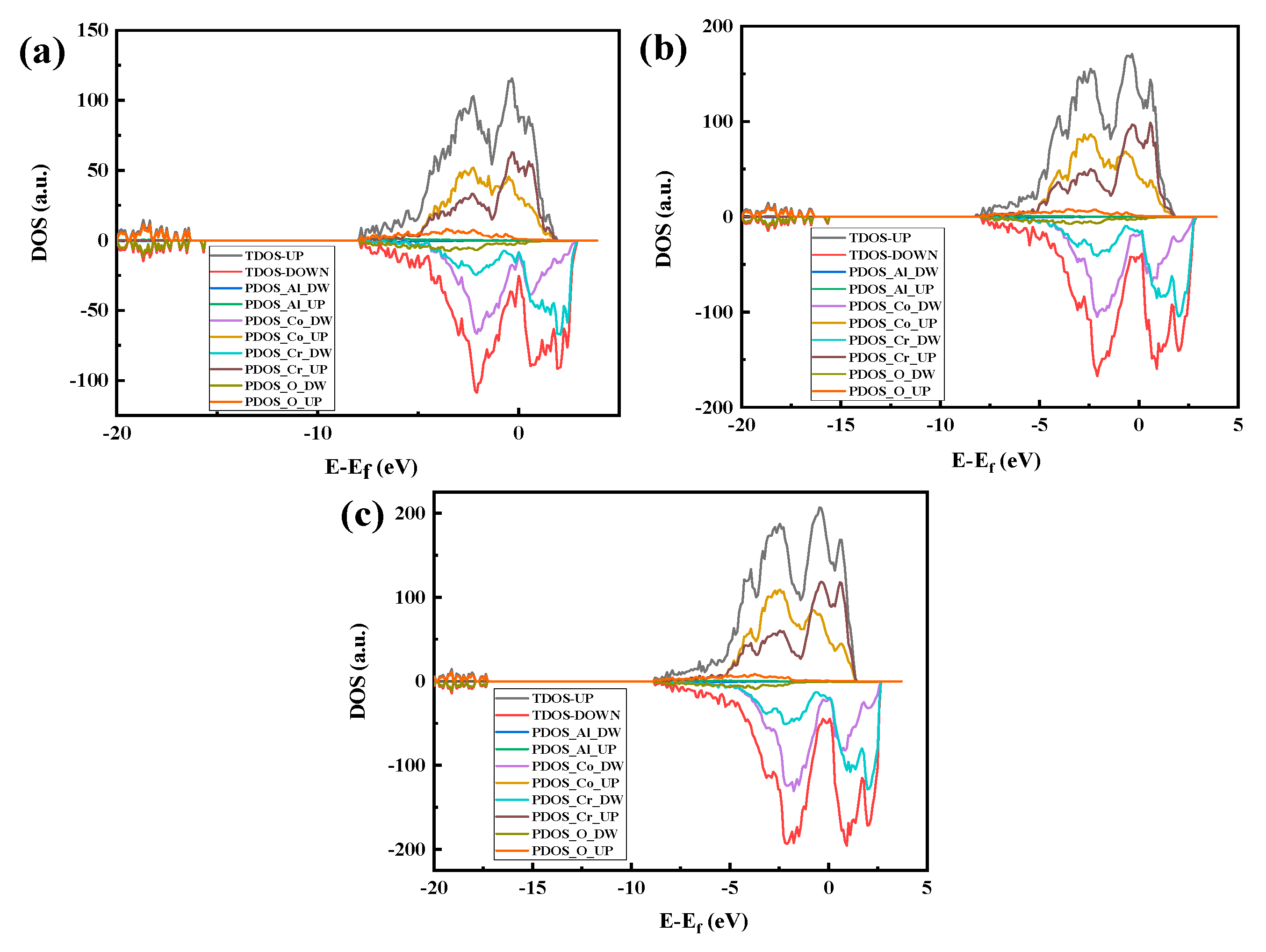
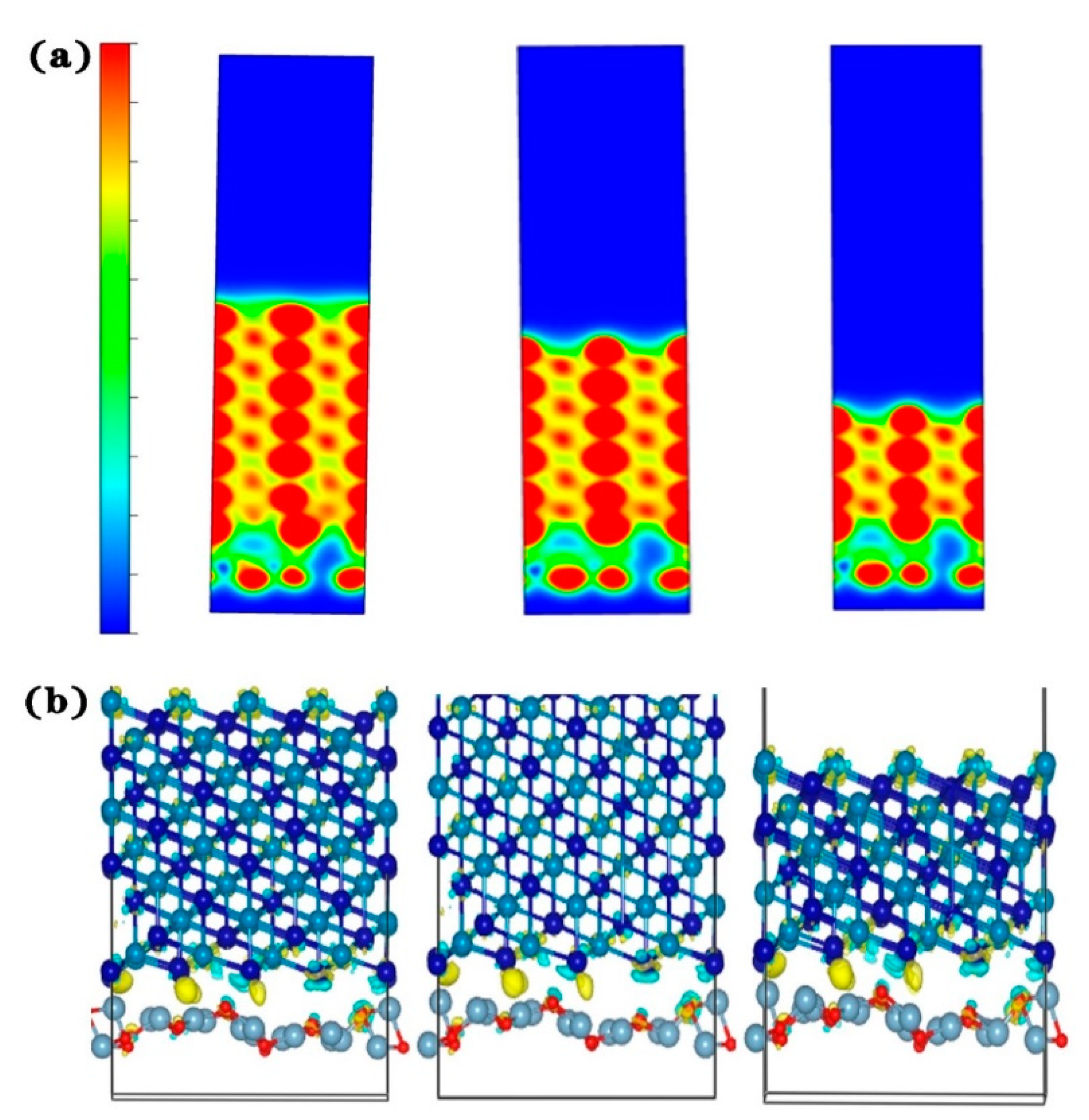
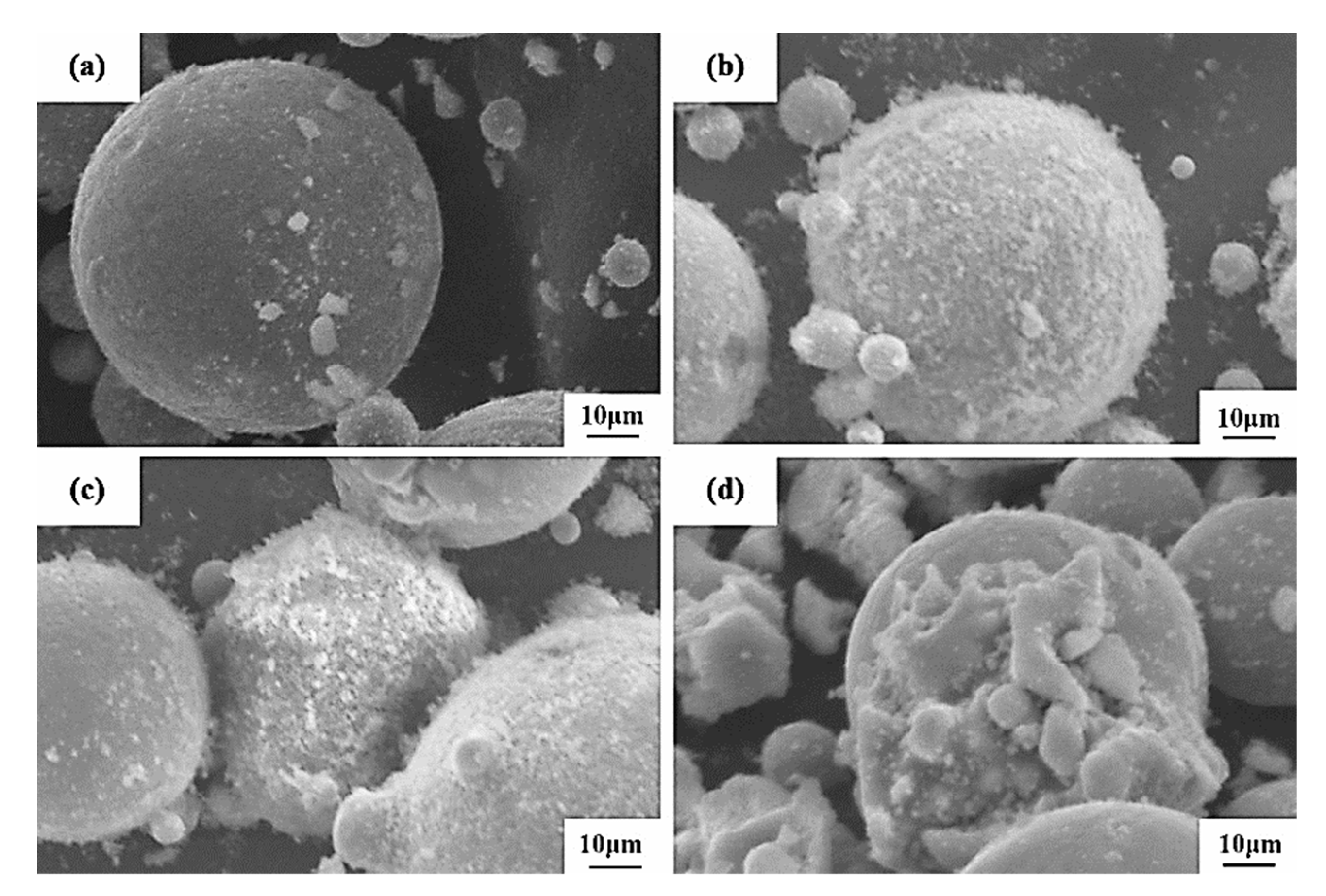
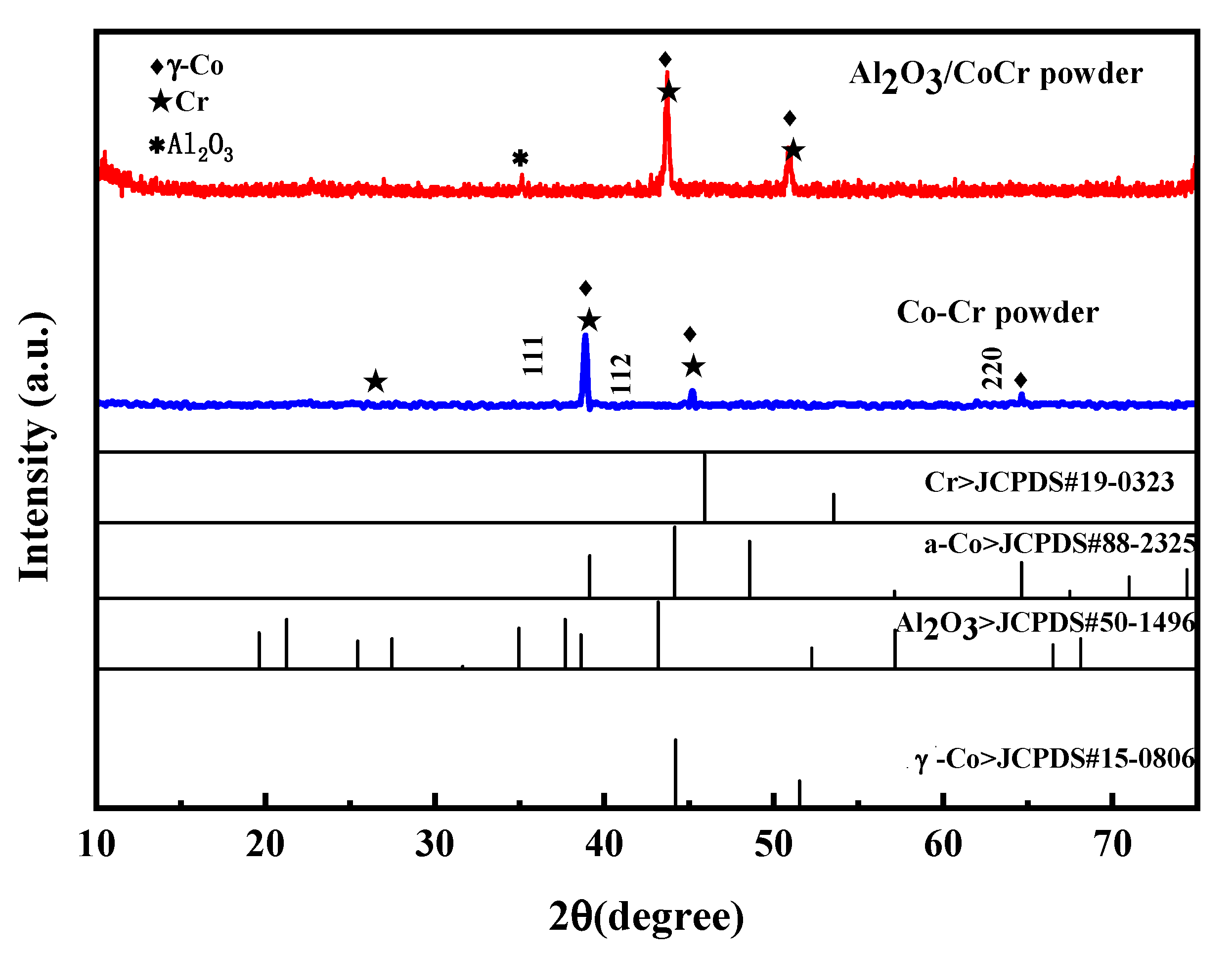

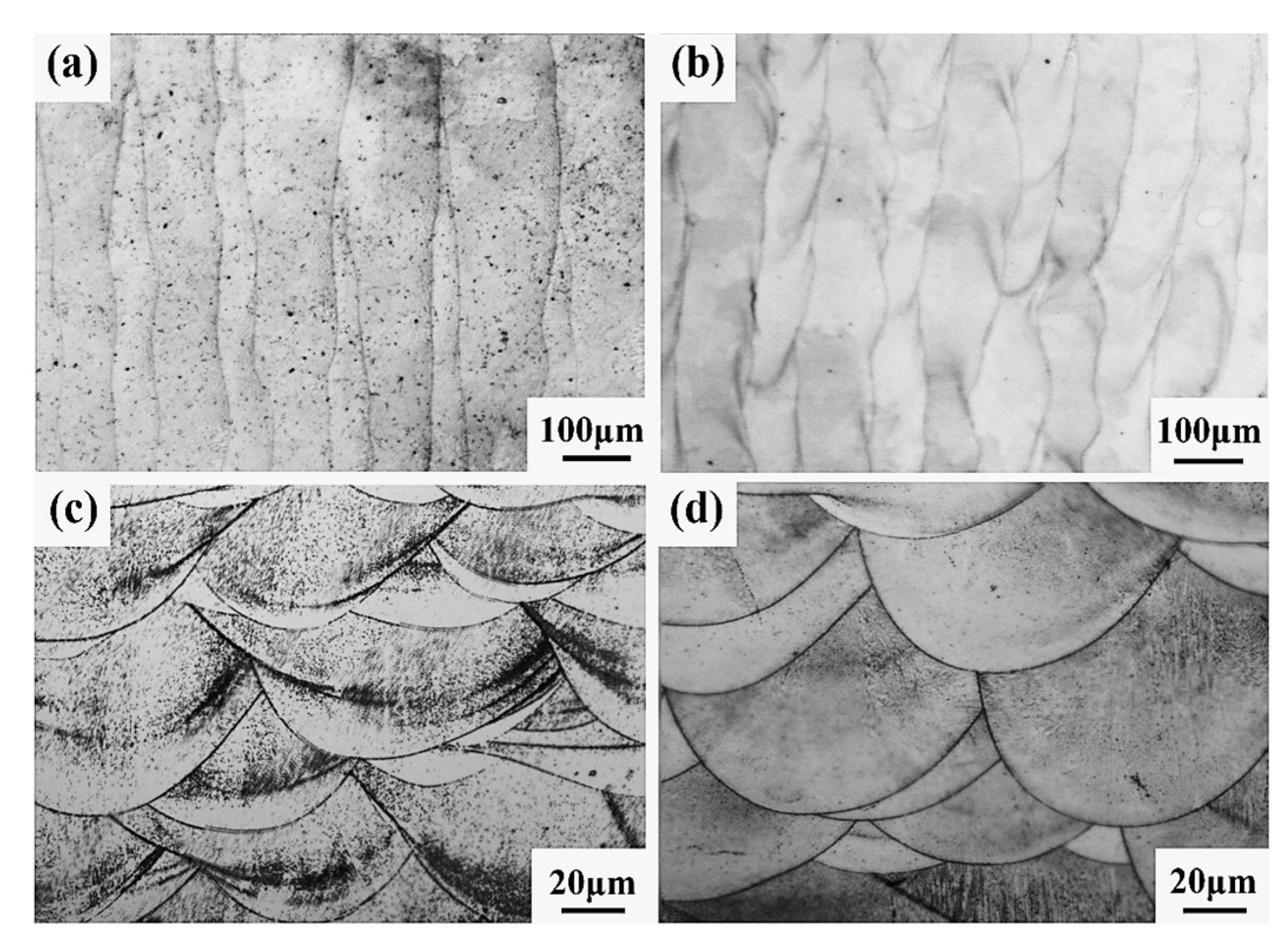
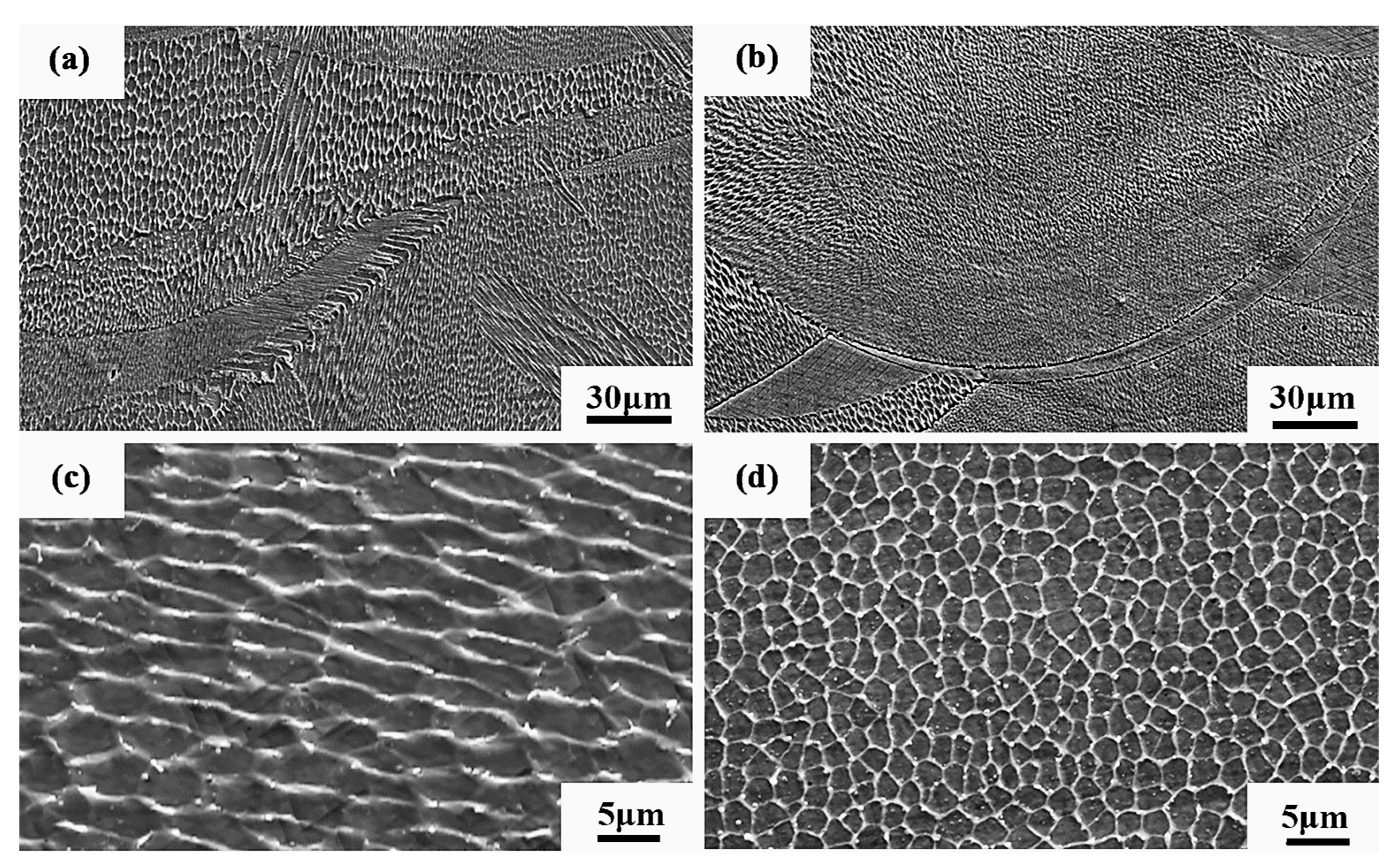
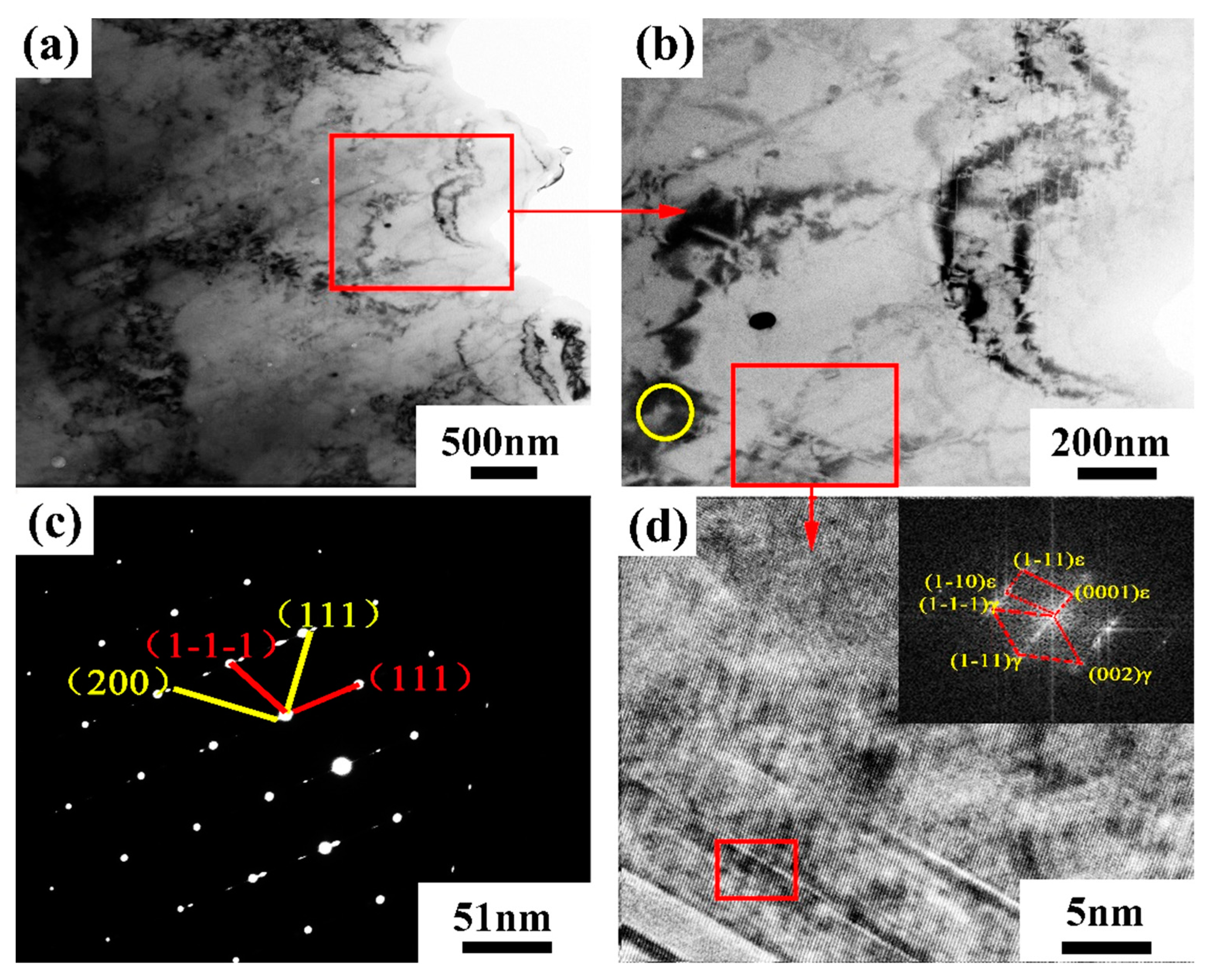
| Chemical Composition | Cr | Mo | Si | Mn | Fe | C | Co |
|---|---|---|---|---|---|---|---|
| Content (%) | 29.5 | 5.3 | 0.7 | 0.5 | 0.4 | 1.2 | Others |
| CoCr | a | b | c | α = β | γ |
|---|---|---|---|---|---|
| Theoretical parameters [25] | 3.545 | 3.545 | 3.545 | 90 | 90 |
| Parameter after optimization | 3.553 | 3.553 | 3.553 | 90 | 90 |
| Type | Density/(g·cm−3) | Property | Structure | Stability |
|---|---|---|---|---|
| γ-Al2O3 | 3.2~3.4 | Strong reactivity | FCC | Metastable |
| Cubic | state | |||
| θ-Al2O3 | 3.6 | Center | HCP | Metastable |
| Monoclinic | state | |||
| α-Al2O3 | 3.97 | Poor activity High-hardness | HCP Rhombohedral | Steady state |
| Al2O3 | a | b | c | α = β | γ |
|---|---|---|---|---|---|
| Theoretical parameters | 4.759 | 4.759 | 12.991 | 90 | 120 |
| Optimized after parameters | 4.796 | 4.796 | 13.089 | 90 | 120 |
| Number of Plies (N) | Eslab (cV) | σ (J/m2) |
|---|---|---|
| 4 | 0.884 | 1.121 |
| 5 | 0.719 | 1.035 |
| 6 | 0.693 | 1.0545 |
| 7 | 0.435 | 0.43239 |
| Number of Plies (N) | σ (J/m2) | ||
|---|---|---|---|
| CoCr (100) | CoCr (110) | CoCr (111) | |
| 4 | 2.56 | 2.83 | 2.37 |
| 5 | 2.33 | 2.01 | 2.89 |
| 6 | 2.51 | 1.63 | 1.98 |
| 7 | 1.78 | 1.75 | 1.76 |
| 8 | 1.35 | 1.87 | 2.01 |
| Structure | Lattice Parameters (Å) | ε (%) |
|---|---|---|
| Al2O3 (111)/CoCr (100) | a = 8.32, b = 13.96, c = 22.00 | 7.98 |
| Al2O3 (111)/CoCr (110) | a = 8.56, b = 13.54, c = 21.00 | 8.03 |
| Al2O3 (111)/CoCr (111) | a = 8.62, b = 12.54, c = 27.00 | 7.41 |
| Structure | Wad (J/m2) | Wsep (J/m2) | Efor (J/m2) |
|---|---|---|---|
| Al2O3 (111)/CoCr (100) | 2.06 | 2.02 | 0.19 |
| Al2O3 (111)/CoCr (110) | 1.93 | 1.83 | 0.21 |
| Al2O3 (111)/CoCr (111) | 2.33 | 2.12 | 0.11 |
| Group | Mixed Ratios |
|---|---|
| 1 | 97.5% CoCr alloy powder + 2.5% Al2O3 |
| 2 | 95% CoCr alloy powder + 5% Al2O3 |
| 3 | 92.5% CoCr alloy powder + 7.5% Al2O3 |
| 4 | 90% CoCr alloy powder + 10% Al2O3 |
| Structure | Wad (J/m2) | Wsep (J/m2) | Efor (J/m2) |
|---|---|---|---|
| 5% Al2O3 | 2.36 | 2.24 | 0.15 |
| 7.5% Al2O3 | 2.01 | 2.08 | 0.16 |
| 10% Al2O3 | 1.99 | 1.87 | 0.19 |
| Type of Powder | Particle Size Distribution (μm) D10–D90 |
|---|---|
| CoCr alloy powder | 18.5–58.6 |
| Add 5% Al2O3 composite powder | 13.2–43.5 |
| Type of Powder | Loose Pack Density (g/cm3) | Liquidity/(s. (50 g)−1) | Degree of Sphericity |
|---|---|---|---|
| YY/T 1702-2020 | ≥4.0 | ≤40 | ≥0.7 |
| CoCr alloy powder | 4.16 | 22.6 | 0.76 |
| Add 5% Al2O3 composite powder | 4.29 | 22.9 | 0.72 |
| Sample | Cell Parameter (FCC) a-Co (nm) | Cell Parameter (HCP) ε-Co (nm) | Fraction of Volume HCP FHCP |
|---|---|---|---|
| CoCr powder | a = 0.3534 ± 0.0002 | - | - |
| SLM CoCr alloy | a = 0.3573 ± 0.0005 | a = 0.2533 ± 0.0003 c = 0.392 ± 0.002 c/a = 1.548 | 0.605 ± 0.005 |
| SLM Al2O3/CoCr Composite material | a = 0.3568 ± 0.0001 | a = 0.2528 ± 0.0002 c = 0.399 ± 0.003 c/a = 1.578 | 0.168 ± 0.02 |
Disclaimer/Publisher’s Note: The statements, opinions and data contained in all publications are solely those of the individual author(s) and contributor(s) and not of MDPI and/or the editor(s). MDPI and/or the editor(s) disclaim responsibility for any injury to people or property resulting from any ideas, methods, instructions or products referred to in the content. |
© 2023 by the authors. Licensee MDPI, Basel, Switzerland. This article is an open access article distributed under the terms and conditions of the Creative Commons Attribution (CC BY) license (https://creativecommons.org/licenses/by/4.0/).
Share and Cite
Hong, Q.; Bai, P.; Zhao, Z.; Wang, J. First-Principle Study of the Interface of Al2O3/CoCr Metal-Based Composites. Coatings 2023, 13, 680. https://doi.org/10.3390/coatings13040680
Hong Q, Bai P, Zhao Z, Wang J. First-Principle Study of the Interface of Al2O3/CoCr Metal-Based Composites. Coatings. 2023; 13(4):680. https://doi.org/10.3390/coatings13040680
Chicago/Turabian StyleHong, Qin, Peikang Bai, Zhanyong Zhao, and Jianhong Wang. 2023. "First-Principle Study of the Interface of Al2O3/CoCr Metal-Based Composites" Coatings 13, no. 4: 680. https://doi.org/10.3390/coatings13040680
APA StyleHong, Q., Bai, P., Zhao, Z., & Wang, J. (2023). First-Principle Study of the Interface of Al2O3/CoCr Metal-Based Composites. Coatings, 13(4), 680. https://doi.org/10.3390/coatings13040680







